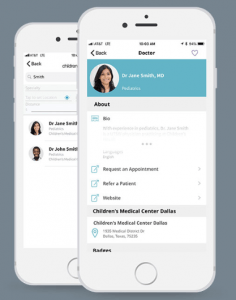
By: Ruth Ferguson, NDG Editor
Children’s Health is helping to expand virtual healthcare, also referred to as telehealth, access for North Texas patients. The Children’s Health Virtual Visit app not only provides convenience for those suffering from common illnesses, but it also can be more affordable, even for those without health insurance.
The app was launched about two and a half years ago, and user adoption continues to grow, particularly with millennial parents. During cold and flu season, one of the Children’s providers at a particular location may see 10-15 patients in a day.
“People are familiar with the technology now. They view it as a super simple way to be seen by a provider,” Ken Dakin, Virtual Visit provider, who serves as a physician assistant at Children’s Health, said during a recent conversation regarding the initiative.
Quality patient care remains the top priority
Tech-savvy patients use a smartphone or tablet for the conversation with the healthcare team at Children’s Health. Naturally, some patients have questions about the quality of care they are receiving. However, the Children’s Health team emphasizes patient safety is never compromised. If necessary, they are directed to immediately see a doctor. The program is primarily designed for everyday healthcare situations such as flu, colds, bug bites, allergies, etc.
“How can a doctor treat me without running a test or putting their fingers on me, and in some cases that is true,” Dakin shared. However, he points out tests frequently are requested primarily to confirm a diagnosis “We use a test to confirm our suspicions. Usually, I kinda know what you have.” A seasoned provider is comfortable with recognizing key symptoms through how the patient’s symptoms present and their reaction to questions.
According to Dakin, using the app is actually faster than visiting a neighborhood urgent care location. Once the patient downloads the app and completes their demographic info, includes insurance info, if applicable, they can contact speak to a healthcare provider and have a prescription called into the pharmacy in less than 30 minutes. All from the comfort of their own home or office.
“Many times patients will get the same service, and interaction you would get with a physician,” Dakin added.
At less than $60 for the patient, while reducing overhead costs, this is seen as an affordable win-win situation for the providers and the patients.
“Virtual medicine saves them money,” Dakin stated. “The insurance never concerned us that much because we felt the price point was fair for the value and treatment.
Parents and seniors benefit from the healthcare tech tool
The population most comfortable with the tech tool is parents with little ones. Time and finances are not the only elements they love, but it is also all about getting little Johnny better quickly, without getting their other children sick or even themselves.
“They don’t want to expose their little ones to germy people,” according to Dakin. Also, parents don’t want to be a risk of being exposed to others who are sick. “It is super convenient for them to make a virtual visit.”
This can also improve access to healthcare for seniors who are on a fixed budget and too often have transportation issues. Plus it reduces their exposure to viruses during flu season, which can have deadly consequences for their population.
Children’s also has a telemedicine partnership arrangement with several of North Texas school districts including Dallas, Garland, and Plano. The child can visit the school nurse, who administers the strep and flu test at the school. If positive, Children’s can call in the prescription. This reduces the amount of time the child is ill because typically parents are not able to get a same-day visit, especially at the height of flu season.




